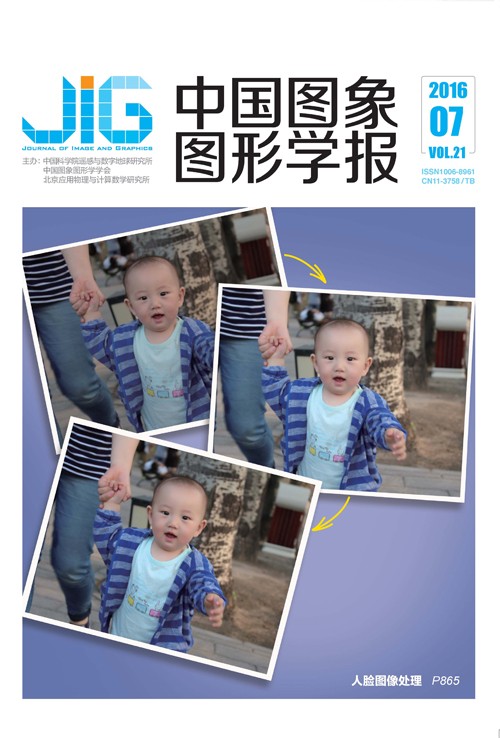
TDFA:一种生成空间影像金字塔的方法
摘 要
目的 降采样滤波是生成空间金字塔影像数据的主要手段,但目前没有一种客观指标来鉴别滤波器的降采样效果,因为至少需要空间金字塔的两层原始信号才能计算滤波器的降采样峰值信噪比(PSNR)。为解决此难题,本文建立一种研究路线:先基于视频影像数据评选确定一个性能优秀的降采样滤波器,然后验证该滤波器降采样生成遥感金字塔的主观目视效果,提出一种沿图像纹理方向滤波的降采样方法TDFA(texture direction filtering approach),可生成高质量的空间影像金字塔。方法 本文把降采样与升采样结合提出一种重采样滤波对偶RSFP(re-sampling filter pair),作为当前层金字塔数据的一个逼近,用来评价降采样滤波器效果。基于RSFP评价手段,筛选出一种基于纹理滤波的金字塔生成方法TDFA:对每个8×8块,TDFA在直流、水平、135°、垂直和45°等5个方向中搜索确定图像的一个纹理方向,用一个3阶滤波器沿纹理方向实施降采样,效果优于目前最好的最邻近插值方法,无任何伪彩、锯齿、块效应或马赛克。结果 利用大量影像数据实验,同几个典型滤波器的降采样效果对比,TDFA提升平均PSNR的范围,对拉格朗日滤波器是7.29~8.44 dB;对双线性滤波器是6.26~7.40 dB;对AVS的1/4插值滤波器是5.80~6.84 dB;对最邻近插值是4.51~5.70 dB。结论 本文提出的纹理滤波降采样算法可以生成质量优于现有最好水平的遥感金字塔影像,也可以生成高质量的多层视频流媒体数据。所提出的重采样滤波对偶RSFP可以输出当前层的高精度预测,用于可伸缩视频编码处理。
关键词
TDFA: a generation method of spatial image pyramid
Zhang Yunzhou1, Zhang Mo1, Wang Jinnian2, Zhang Gang1(1.Taiyuan University of Technology, Taiyuan 030024, China;2.Institute of Remote Sensing and Digital Earth, Chinese Academy of Sciences, Beijing 100080, China) Abstract
Objective Currently, downsampling filtration is the main method of generating a spatial image pyramid data, but any objective indicator has not occurred to evaluate the effect of a downsampling filter because calculating the filter's downsampling PSNR requires at least two layers of original data of a spatial pyramid. This study establishes the research technology roadmap of solving this problem:based on two-layer original signals of video image data, an excellent performance downsampling filter was discovered and identified and the subjective visual effect of its generation of the remote-sensing pyramid was verified. Finally, we proposed a downsampling method of filtering along the image texture direction to generate a high-quality spatial pyramid image. Method Downsampling and upsampling were presented to have been combined to form a pair of resampling filters, as RSFP served as an approximation of the current layer data of pyramids, which can be used to evaluate the downsampling filtering effect. Based on RSFP, a novel pyramid-generating approach TDFA was established:For each 8×8 block, TDFA searches to determine the one-texture orientation of the image from five directions, i.e., DC, horizontal, 135°, vertical, and 45°, and filters along the texture direction implementation of downsampling with a three-order filter, with its effect better than the currently best nearest neighbor interpolation, and the pseudo color, zipper, mosaic, or block effect does not exist. Result Experimentation and comparisonof effect using a large quantity of image data with several typical downsampling filters, the increasing range of average PSNR by TDFA, was approximately 7.29 dB to 8.44 dB for the Lagrange filter; approximately 6.26 dB to 7.40 dB for the bicubic filter; approximately 5.80 dB to 6.84 dB for AVS's 1/4 interpolation filter; and approximately 4.51 dB to 5.70 dB for the nearest neighbor interpolation method. Conclusion This study proposed a type of texture-filtering algorithm TDFA. This algorithm can be used to generate the remote sensing pyramid, with its quality better than the level of the existing best generation method, and can also be used to generate a high-quality multilayer video-streaming media data. The proposed resampling filtering pair RSFP can output the high-precision prediction of the current layer of the pyramid used for a scalable video-encoding process.
Keywords
image pyramid down-sampling up-sampling re-sampling filter pair texture filtering evaluation of filter
|



 中国图象图形学报 │ 京ICP备05080539号-4 │ 本系统由
中国图象图形学报 │ 京ICP备05080539号-4 │ 本系统由